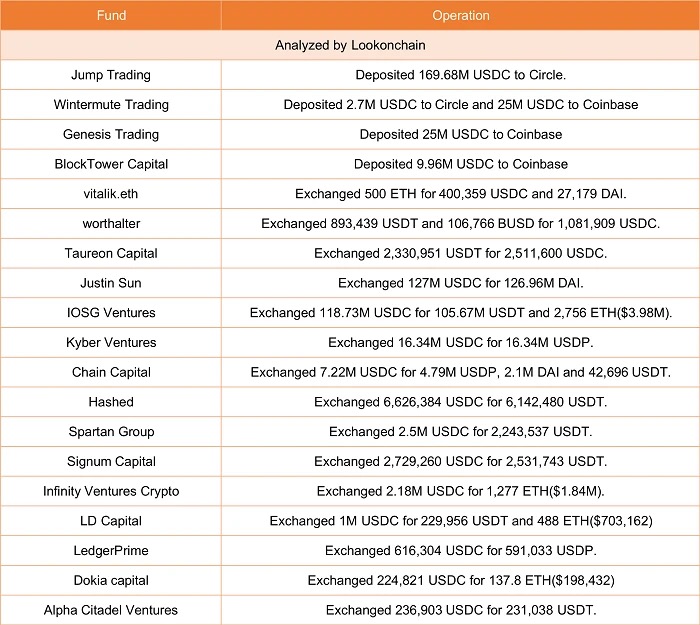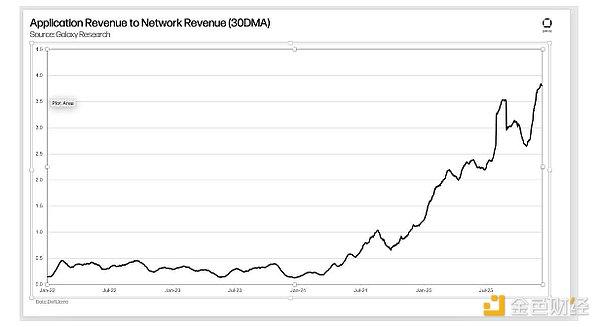On March 11, Circle, the issuer of USDC, stated that 3.3 billion of USDC’s 40 billion reserves were deposited in Silicon Valley Bank. Prior to this, Silicon Valley Bank was forced to close due to “insufficient Liquidity and insolvency” and designated The Federal Deposit Insurance Corporation (FDIC) takes over.
Although Circle is only affected by a small part of the funds, because the bank does not work on weekends, the large-scale purchase of USDC to redeem the US dollar arbitrage mechanism has failed, and Coinbase has also closed the US dollar withdrawal channel of USDC, USDC, DAI, FRAX, MIM Wait for the Stablecoin to be unanchored one after another. In the case of violent market fluctuations, there are also some opportunities.

Institutional Operation of Lookonchain Statistics
Bottom Fishing: USDC losses are limited and there is a high probability that it will return to around $1
The simplest operation is to wait for the USDC to fall before Bottom Fishing bottoms. The basis is that the proportion of USDC reserves affected by Silicon Valley Bank does not exceed 10%, then the current theoretical value of USDC should exceed 0.9 US dollars, and USDC falling below 0.9 US dollars is a suitable opportunity to Bottom Fishing.
This has taken into account the extreme cases of Silicon Valley Bank being liquidated and unable to recover funds at all, and Circle sitting idly by. In fact, Silicon Valley Bank also has many supporters because of its good reputation in the venture capital industry. According to Bloomberg, more than 100 banks have signed a statement supporting Silicon Valley Bank, and investors will continue to maintain relationships with Silicon Valley Bank if other entities acquire Silicon Valley Bank.
On March 12, Circle also announced that if Silicon Valley Bank’s funds cannot be 100% repaid, Circle will use company resources to make up for the shortage to support USDC. USDC Liquidity operations will return to normal after U.S. banks open next Monday.
Under the excessive FUD sentiment, some investors may worry that other U.S. banks may follow in the footsteps of Silvergate and Silicon Valley Bank. The stock price of First Republic Bank (FRC) fell more than 50% when it opened on Friday. The Federal Reserve and FDIC are considering setting up a fund to guarantee deposits for struggling banks, according to Bloomberg.
Investors who directly Bottom Fishing also need to pay attention to the dynamics in real time, so as not to put themselves in an unfair position. For example, when the FTX risk was just exposed, the ratio of the capital gap to the total deposit was not high, but because many people withdrew in full, and after the withdrawal was closed, FTX also opened withdrawals to some people through special channels, resulting in no People who withdraw money can lose 100% of their funds.
Even if there are risks, there is a high probability that USDC will recover to a price close to $1 on Monday.
Hedging: USDC swaps with BUSD and DAI
After USDC is unanchored, you can choose to exchange USDC 1:1 for other Stablecoin, hoping that the issuers of other Stablecoin can cover the bottom line. If USDC returns to $1, there will be no loss; if USDC continues to de-anchor, issuers of other Stablecoin may also make up for the shortfall of USDC.
The first is the swap between BUSD and USDC. By default, Binance converts the USDC recharged by users into BUSD. Therefore, in the early stage of USDC de-pegging, BUSD and USDC can still be swapped at Binance at a ratio of 1:1. In the case that USDC has been unanchored, BUSD is theoretically less risky than USDC, and it may have Binance's pocket. The fact is also true. As the unanchor of USDC continued, Binance closed the swap channel between USDC and BUSD. Since then, the negative premium of BUSD has remained at about 1%, while the negative premium of USDC has exceeded 10%.
The second is the swap between DAI and USDC. Maker's stable anchor module allows the swap between DAI and USDC. In the absence of other channels to avoid risks, DAI is also a better choice than USDC, because some DAI is minted with over-collateralized cryptocurrencies, and MakerDAO may cover the bad debts in the agreement. Sun Yuchen, the founder of Tron , also carried out this operation. Afterwards, MakerDAO did take positive measures. The negative premium of DAI is lower than that of USDC.
Arbitrage: price differences between different chains and DEXs
When the price of USDC fluctuates, there are also many arbitrage opportunities in the market. The core of this idea is to observe the price difference of the same asset between different chains and centralized exchanges.
For example, the price of ETH/USDC trading pairs on Optimism and Arbitrum is different from that on OKX, so it is necessary to use trading aggregators such as 1INCH. Even if the price of ETH /USDC on a single DEX is the same as the exchange, it can also be arbitraged through the composability of DeFi . One of the operations is to use USDC to purchase ETH through Optimism's 1INCH , and then exchange it for USDC on OKX, Bybit and other platforms. When USDC depreciates, the transaction will go through the path of "USDC-sUSD-sETH- ETH", and it will be completed through Synthetix's atomic transaction. The core reason may be that after the price of USDC fell, the price of the USDC/sUSD trading pair on the chain did not change, and Stableswap would lead to Liquidity accumulation, thus providing considerable Liquidity.
Since OKX supports the deposit and withdrawal of more assets on different chains (such as Optimism, Arbitrum’s USDC), and has opened more trading pairs with good Liquidity(such as ETH/USDC), more funds have flowed in in the short term. Afterwards, Binance also resumed the USDC/USDT trading pair, and said it would open trading pairs such as ETH/USDC.
Finally, PANews would like to remind everyone to be careful when operating on the chain. A negative lesson is that a user sold more than $2 million of Curve 3pool LP tokens through Kyber’s aggregation routing, and only received 0.05 USDT. The reason is that the user neither followed the procedure (the Liquidity should be redeemed directly through Curve), nor paid attention to the price when exchanging, and finally the MEV robot made a profit of more than 2 million US dollars.








